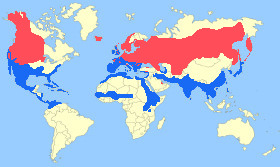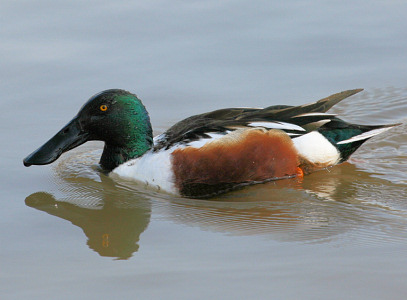Appearance:
Male - The male Northern Shoveler has a metallic green head, yellow-orange eyes, large black spatula shaped beak, white breast, chestnut undersides and flanks, the rump and upper-tail are black, the sides of the rump are white, pale-blue forewing feathers, green speculum bordered with white, and the legs and feet are orange-red.
Female - The female has the same large spatula shaped beak which is grey-brown, and is mostly mottled-brown and buff with a bluish shoulder patch.
Eclipse - The male in eclipse plumage is similar to the female but has a darker head, reddish flanks, retains the wing colour as well as the yellow eyes and dark beak.
 |
 |
 |
Size - Typical Adult is about 48cm (19in).
Food - Uses large beak to filter small animals, insects and plankton from the water. Also feeds on weeds, seeds, insects, and molluscs.
Habitat/Range: - Wetlands, wet grassland, lakes and marshes in northern Europe into Asia and the north-west of North America. Winters further south in southern Europe, north Africa, India, Vietnam, south China, Japan, south-western USA, Mexico, Central, and northern South America.

 Breeding Habitat/Resident,
Breeding Habitat/Resident,  Migration or Winter Area.
Migration or Winter Area.Breeding Season - Early April to June in southern parts.
Eggs - 8 to 12 (pale-buff and olive-tinted colour).
Notes - The Northern Shoveler is a dabbling duck with an extremely large range from North America, Europe to Asia.
Conservation status (IUCN 3.1):
Least Concern.
Classification - Family: Anatidae,
Subfamily: Anatinae, Genus: Anas.







































